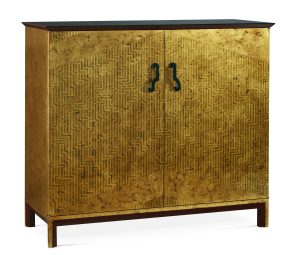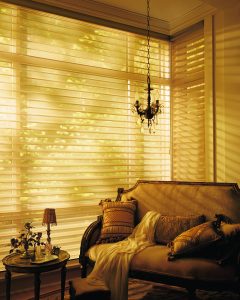
The Nara Chest from Baker Furniture has a distressed gold finish with brick red bevels and basalt finish on top and interior.
For thousands of years, the lustre and legend of gold has attracted and inspired – the ultimate symbol of wealth, power and beauty. More subtle, but mystically powerful, the iconic forms of hexagons and honeycombs have shaped architecture, art and religious beliefs. Hexagons are found both in nature and in structures throughout the ancient worlds of Egypt, Israel, China and India. Hexagonal shapes have been discovered in the perfectly planned geometry of Stonehenge, in medieval European churches and in structures at Colonial Williamsburg.
From a bold yellow to an understated shimmer, shades of gold abound from soft rose gold jewelry and accessories to interior design where gold is trending in subtle and stylish ways. Furnishings appear in antiqued, brushed and burnished versions that add glamour and depth to a room.

Hunter Douglas sets the gold standard with technical innovation and dynamic use of colour and fabric. Shown above, Alustra Silhouette window shadings in Gold Radiance fabric and hardware.
This trend is reflected in the warm metallic gold finish in the Gold Radiance hardware and golden-hued fabrics in the Hunter Douglas Alustra Collection of window fashions, “which are built on a foundation of exclusivity and design with signature elements such as distinctive fabrics, hardware finishes and systems,” says Kim Kiner, vice president of the Alustra Collection and the Design Studio Roman Shades at Hunter Douglas.
Kiner is also a trend spotter. “Gold is back in a big way,” she says, “but at our company we say it never went away.” From its beginnings, this leading window fashions manufacturer has harnessed natural sunlight to illuminate, energize and beautify interiors. Radiant light is diffused through window shades in an array of colours and customized fabrics.
In the pioneering of its energy-saving and high-design window dressings, Kiner says that Hunter Douglas relied on another iconic element – the hexagonal, honeycomb shape. Rich in symbolism and history, it forms the basis for many revered icons, including the Flower of Life, the symbol of creation and the Star of David. Hexagonal patterns have graced palaces and places of worship since ancient times and are found in Indian, Islamic and Egyptian art.

This stunning tiara was designed for Queen Elizabeth The Queen Mother by Cartier in 1947. The hexagon shapes set off the diamonds’ brilliance while lending this very traditional headpiece a contemporary style.
The iconic pattern is popular today – a timeless shape that enhances any design period. Variations of the hexagon appear in wallpaper, flooring, furniture, home accessories and as a favourite shape in logos, ornamentation, and art.
Hexagons are also integral to some of today’s most revolutionary and dynamic architecture, providing both form and function to buildings from Beijing to Berlin. With the royal tiara as a dazzling example, the hexagon has always shaped jewelry as a design element and also as a symbol of creation, divine power and love.
In 1985, Kiner points out, Hunter Douglas took this iconic shape to a new level of design and utility by introducing the ground-breaking Duette honeycomb shade design. Today, it is an integral element in the company’s most popular, energy-saving products.

Alustra Duette Architella honeycomb shades from Hunter Douglas combine on-trend gold fabrics and hardware with the equally on-trend and energy-efficient honeycomb construction.
“The honeycomb is nature’s engineering marvel – and it is also ours,” she continues. “The unique Duette shade construction traps air inside the cells to keep homes warmer in winter and cooler in summer. The company advanced this innovation with the Duette Architella line, which has a ‘cell-within-a-cell’ construction that creates more
air pockets than traditional cellular shades and can substantially reduce energy transfer at the window to create a more comfortable living space. This can also result in impressive savings on utility costs,” she says.
Combined with the equally commanding mystique of gold, the honeycomb design elevates engineering and aesthetics to a new and unsurpassed level. Gold is more than an element, Kiner asserts. “It’s an emblem of power, a pledge of eternal love, the coin of many a realm − a coveted prize. Gold is the colour of sunlight and champagne, the ultimate measure, and is the universal and enduring standard of quality and value.”
www.newscanada.com
Latest posts by Canadian Home Trends (see all)
- Layer Up – Wrap Your Bathroom In Light - December 20, 2025
- The Power of Rest: Elevate Your Wellness with Better Sleep - December 20, 2025
- VERSATILE KITCHEN DESIGN - December 20, 2025






